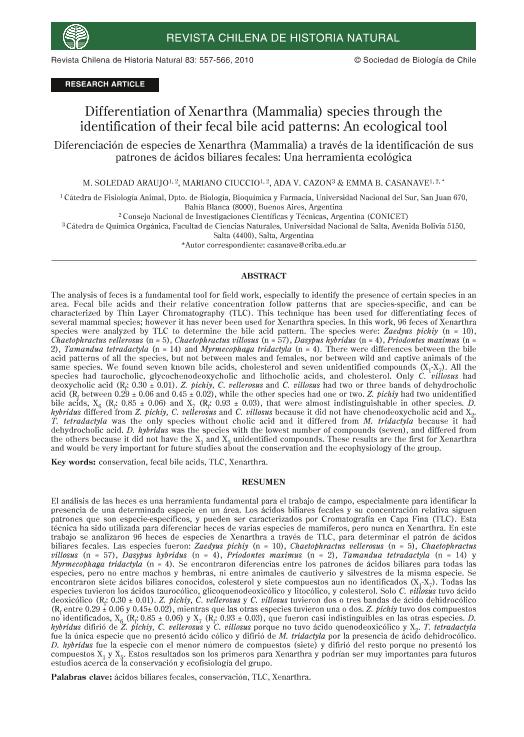Mostrar el registro sencillo del ítem
dc.contributor.author
Araujo, Maria Soledad

dc.contributor.author
Ciuccio, Mariano

dc.contributor.author
Cazón, Ada V.
dc.contributor.author
Casanave, Emma Beatriz

dc.date.available
2019-02-04T14:40:54Z
dc.date.issued
2010-12
dc.identifier.citation
Araujo, Maria Soledad; Ciuccio, Mariano; Cazón, Ada V.; Casanave, Emma Beatriz; Differentiation of Xenarthra (Mammalia) species through the identification of their fecal bile acid patterns: An ecological tool; Sociedad de Biología de Chile; Revista Chilena de Historia Natural; 83; 4; 12-2010; 557-566
dc.identifier.issn
0716-078X
dc.identifier.uri
http://hdl.handle.net/11336/69256
dc.description.abstract
The analysis of feces is a fundamental tool for field work, especially to identify the presence of certain species in an area. Fecal bile acids and their relative concentration follow patterns that are species-specific, and can be characterized by Thin Layer Chromatography (TLC). This technique has been used for differentiating feces of several mammal species; however it has never been used for Xenarthra species. In this work, 96 feces of Xenarthra species were analyzed by TLC to determine the bile acid pattern. The species were: Zaedyus pichiy (n = 10), Chaetophractus vellerosus (n = 5), Chaetophractus villosus (n = 57), Dasypus hybridus (n = 4), Priodontes maximus (n = 2), Tamandua tetradactyla (n = 14) and Myrmecophaga tridactyla (n = 4). There were differences between the bile acid patterns of all the species, but not between males and females, nor between wild and captive animals of the same species. We found seven known bile acids, cholesterol and seven unidentified compounds (X1-X7). All the species had taurocholic, glycochenodeoxycholic and lithocholic acids, and cholesterol. Only C. villosus had deoxycholic acid (Rf: 0.30 ± 0.01). Z. pichiy, C. vellerosus and C. villosus had two or three bands of dehydrocholic acid (R f between 0.29 ± 0.06 and 0.45 ± 0.02), while the other species had one or two. Z. pichiy had two unidentified bile acids, X 6 (Rf: 0.85 ± 0.06) and X7 (R f: 0.93 ± 0.03), that were almost indistinguishable in other species. D. hybridus differed from Z. pichiy, C. vellerosus and C. villosus because it did not have chenodeoxycholic acid and X2. T. tetradactyla was the only species without cholic acid and it differed from M. tridactyla because it had dehydrocholic acid. D. hybridus was the species with the lowest number of compounds (seven), and differed from the others because it did not have the X1 and X5 unidentified compounds. These results are the first for Xenarthra and would be very important for future studies about the conservation and the ecophysiology of the group.
dc.description.abstract
El análisis de las heces es una herramienta fundamental para el trabajo de campo, especialmente para identificar la presencia de una determinada especie en un área. Los ácidos biliares fecales y su concentración relativa siguen patrones que son especie-específicos, y pueden ser caracterizados por Cromatografía en Capa Fina (TLC). Esta técnica ha sido utilizada para diferenciar heces de varias especies de mamíferos, pero nunca en Xenarthra. En este trabajo se analizaron 96 heces de especies de Xenarthra a través de TLC, para determinar el patrón de ácidos biliares fecales. Las especies fueron: Zaedyus pichiy (n = 10), Chaetophractus vellerosus (n = 5), Chaetophractus villosus (n = 57), Dasypus hybridus (n = 4), Priodontes maximus (n = 2), Tamandua tetradactyla (n = 14) y Myrmecophaga tridactyla (n = 4). Se encontraron diferencias entre los patrones de ácidos biliares para todas las especies, pero no entre machos y hembras, ni entre animales de cautiverio y silvestres de la misma especie. Se encontraron siete ácidos biliares conocidos, colesterol y siete compuestos aun no identificados (X1-X7). Todas las especies tuvieron los ácidos taurocólico, glicoquenodeoxicólico y litocólico, y colesterol. Solo C. villosus tuvo ácido deoxicólico (Rf : 0.30 ± 0.01). Z. pichiy, C. vellerosus y C. villosus tuvieron dos o tres bandas de ácido dehidrocólico (Rf entre 0.29 ± 0.06 y 0.45± 0.02), mientras que las otras especies tuvieron una o dos. Z. pichiy tuvo dos compuestos no identificados, X6 (Rf : 0.85 ± 0.06) y X7 (Rf : 0.93 ± 0.03), que fueron casi indistinguibles en las otras especies. D. hybridus difirió de Z. pichiy, C. vellerosus y C. villosus porque no tuvo ácido quenodeoxicólico y X2. T. tetradactyla fue la única especie que no presentó ácido cólico y difirió de M. tridactyla por la presencia de ácido dehidrocólico. D. hybridus fue la especie con el menor número de compuestos (siete) y difirió del resto porque no presentó los compuestos X1 y X5. Estos resultados son los primeros para Xenarthra y podrían ser muy importantes para futuros estudios acerca de la conservación y ecofisiología del grupo.
dc.format
application/pdf
dc.language.iso
eng
dc.publisher
Sociedad de Biología de Chile

dc.rights
info:eu-repo/semantics/openAccess
dc.rights.uri
https://creativecommons.org/licenses/by/2.5/ar/
dc.subject
Ácidos Biliares Fecales
dc.subject
Tlc
dc.subject
Xenarthra
dc.subject
Conservación
dc.subject.classification
Otras Ciencias Biológicas

dc.subject.classification
Ciencias Biológicas

dc.subject.classification
CIENCIAS NATURALES Y EXACTAS

dc.title
Differentiation of Xenarthra (Mammalia) species through the identification of their fecal bile acid patterns: An ecological tool
dc.title
Diferenciación de especies de Xenarthra (Mammalia) a través de la identificación de sus patrones de ácidos biliares fecales: Una herramienta ecológica
dc.type
info:eu-repo/semantics/article
dc.type
info:ar-repo/semantics/artículo
dc.type
info:eu-repo/semantics/publishedVersion
dc.date.updated
2019-01-23T17:50:12Z
dc.identifier.eissn
0717-6317
dc.journal.volume
83
dc.journal.number
4
dc.journal.pagination
557-566
dc.journal.pais
Chile

dc.journal.ciudad
Santiago de Chile
dc.description.fil
Fil: Araujo, Maria Soledad. Consejo Nacional de Investigaciones Científicas y Técnicas. Centro Científico Tecnológico Conicet - Bahía Blanca; Argentina. Universidad Nacional del Sur. Departamento de Biología, Bioquímica y Farmacia. Cátedra de Fisiología Animal; Argentina
dc.description.fil
Fil: Ciuccio, Mariano. Consejo Nacional de Investigaciones Científicas y Técnicas. Centro Científico Tecnológico Conicet - Bahía Blanca; Argentina. Universidad Nacional del Sur. Departamento de Biología, Bioquímica y Farmacia. Cátedra de Fisiología Animal; Argentina
dc.description.fil
Fil: Cazón, Ada V.. Universidad Nacional de Salta. Facultad de Ciencias Naturales; Argentina
dc.description.fil
Fil: Casanave, Emma Beatriz. Consejo Nacional de Investigaciones Científicas y Técnicas. Centro Científico Tecnológico Conicet - Bahía Blanca; Argentina. Universidad Nacional del Sur. Departamento de Biología, Bioquímica y Farmacia. Cátedra de Fisiología Animal; Argentina
dc.journal.title
Revista Chilena de Historia Natural

dc.relation.alternativeid
info:eu-repo/semantics/altIdentifier/url/http://www.scielo.cl/scielo.php?pid=S0716-078X2010000400009&script=sci_arttext
dc.relation.alternativeid
info:eu-repo/semantics/altIdentifier/doi/http://dx.doi.org/10.4067/S0716-078X2010000400009
dc.relation.alternativeid
info:eu-repo/semantics/altIdentifier/url/http://rchn.biologiachile.cl/es/contents/2010v83n4/9.php
Archivos asociados
